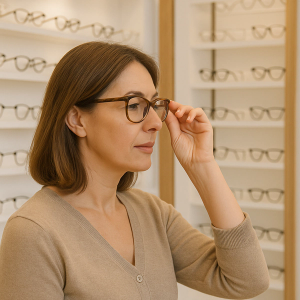Eyeglass Prescriptions Explained

Not all glasses are created equal. Whether you're nearsighted, farsighted, staring at screens all day, or juggling multiple distances, there's a specific type of prescription designed to meet your visual needs.
Understanding the different types of eyeglass prescriptions isn’t just helpful—it can dramatically improve your comfort, productivity, and quality of life. Whether you're updating an old prescription or exploring glasses for the first time, this guide breaks down the four most common types and how they work.
A chart comparing lens types by use case, age group, and focus area.

1. Single Vision Distance
What it is: Lenses designed to correct distance vision (can correct hyperopia or myopia or astigmatism). These prescriptions help you see faraway objects clearly.
Who it's for:
- People who struggle to see road signs, classroom boards, or TV screens
- Common in teens and young adults
How it works: The entire lens has a single prescription tailored for distance. It doesn’t assist with near or mid-range tasks.
2. Single Vision Readers
What it is: Lenses used for up-close tasks such as reading, writing, or crafting. These help correct farsightedness or age-related near-vision loss (presbyopia).
Who it's for:
- Adults over 40 who find it harder to read small print
- People who notice they’re holding items farther away to focus
How it works: These prescriptions include an ADD value (which may be entered into the SPH for reading lenses). They magnify near objects but aren’t helpful for distance or mid-range clarity.
3. Progressive Lenses
What it is: Multifocal lenses with no visible lines that provide smooth transitions between three focal areas: distance, intermediate, and near.
Who it's for:
- Adults over 40 dealing with presbyopia
- People who want one pair of glasses for everything: driving, screen use, and reading
How it works: Progressive lenses contain increasing prescription power from top to bottom, with:
- The top for distance vision
- The middle for intermediate vision (e.g. computer work)
- The bottom for reading
They may take some time to get used to, but many people prefer them to constantly switching between different glasses.
4. Computer Glasses (Mid-Distance)
What it is: Lenses specifically designed to reduce digital eye strain during computer and office work. These lenses optimize vision at intermediate distances (typically 20–26 inches).
Who it's for:
- Office workers, students, or anyone who spends hours on screens
- People with neck or shoulder tension from leaning forward to see their screens clearly
How it works: Computer glasses can be single vision (set for mid-distance) or multifocal (with a larger intermediate zone). They may include blue light filtering or anti-glare coatings.
Which Type Do You Need?
The best eyeglass prescription depends on your lifestyle, age, and visual habits. Are you reading a lot? Driving at night? Jumping between screens and paperwork? Knowing what you need to see clearly helps your optometrist recommend the right prescription.
At Eyebot, our kiosk provides a free, 90-second vision test to help you identify prescription changes for near, mid, or distance vision—doctor-verified and easy to access without an appointment.
Not sure which kind of glasses you need? Start with a free vision test at an Eyebot kiosk and find out in just 90 seconds.


